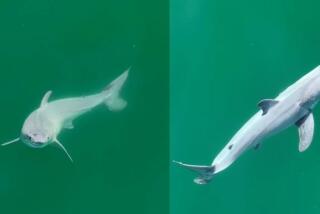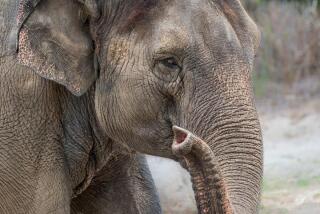Life, and the Shows, Go On at Sea World : Prognosis Is Good for Orphan Shamu
- Share via
Baby Shamu, Sea World of San Diego’s 11-month-old killer whale, stands an excellent chance of remaining healthy in the wake of its mother’s death, marine mammal experts said Tuesday.
They also expressed optimism that the calf will rapidly adjust to life without its mother, Kandu, who died Tuesday after a collision with another whale.
Sea World on Tuesday included Baby Shamu in abbreviated shows alongside Corky, the mature female involved in the death of her mother. Baby Shamu spent much of Tuesday swimming in the water near Corky, according to Dr. Jim McBain, Sea World’s chief veterinarian.
The 1,000-pound calf was still nursing before Monday’s accident, but marine biologists believe that the calf’s nutritional needs will be met because it had been eating as much as 50 pounds of fish daily.
“As far as (surviving), it’s a real plus that it’s eating solid food,” said Marilyn Dahlheim, a biologist with the National Marine Fisheries Service’s marine mammal laboratory in Seattle. “Not to defend the parks, but it’s got a good chance of surviving because of where it’s at. . . . There’s a high mortality rate for calves in the wild.”
The calf’s nutritional needs should be met if it continues to eat the daily supply of fish provided by Sea World trainers, said Sonny Allen, training director of marine mammals at Marine World in Vallejo, which has two killer whales.
Killer whales in the wild often continue to nurse for years, but “in this instance, the calf should do just fine,” said Deborah Duffield, a marine biologist at Portland State University. “There seems to be little worry,” he said, because it has been feeding on solid food for some time.
“This is where all the time and care that Sea World’s staff spends comes into play,” Allen said. “The trainers will try to maintain and strengthen the bond” they have developed with the calf.
Six baby killer whales are in captivity in marine parks in the United States and Canada. Sea World owns five of those captive-born whales.
The first killer whale calf to survive in captivity was born at Sea World of Orlando, Fla., on Sept. 26, 1985. It has been performing alongside other whales there.
The first killer whale born at Sea World’s San Diego park died because of respiratory complications that developed days after its birth in September, 1986.
Baby Shamu was born Sept. 23, 1988, during an afternoon show in Sea World’s 5-million-gallon Shamu Stadium. About 2,500 spectators at a regularly scheduled performance witnessed the birth. Sea World now has baby whales at its parks in San Diego, San Antonio, Tex., and Orlando.
The world’s most recent captive birth, which took place Aug. 16 at Marineland in Niagara Falls, Ont., was unusual in two respects: The calf was the first male born in captivity and the birth caught park officials completely by surprise.
“We were embarrassed,” acknowledged Marineland General Manager Angus Matthews. “As Nootka (a female whale) was brought into the show pool, we noticed to our initial horror--and then our surprise and delight--that there was an extra set of flippers.”
The birth was witnessed by 5,000 spectators. Marineland, which has lent a pair of breeding-age whales to Sea World, “didn’t think the female was sexually mature. . . . Obviously, we were wrong.”
For the past week, the Canadian park’s staff has remained “in constant, twice-a-day contact with Sea World,” Matthews said.
More to Read
Sign up for Essential California
The most important California stories and recommendations in your inbox every morning.
You may occasionally receive promotional content from the Los Angeles Times.










